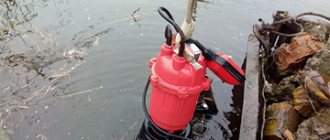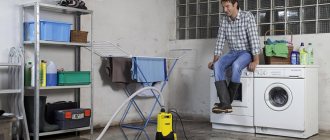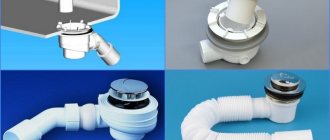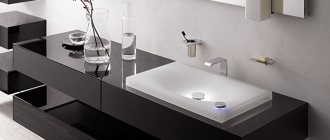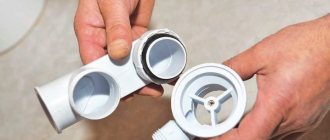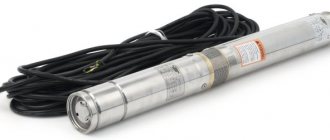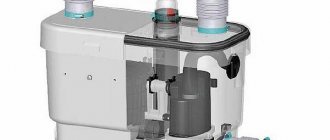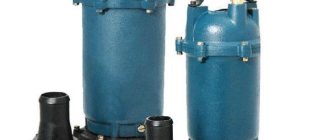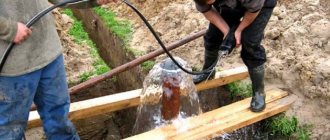Suburban construction is gaining momentum every year. It allows you to solve the housing problem, guarantees fresh air and a beautiful view from the window. True, there are big problems with infrastructure in most cottage villages. Water supply is one of the most important. The well, of course, partially solves it, but the townspeople, accustomed to comfort, are not ready to put up with such a solution. Almost every site has an autonomous water supply system installed or already in operation. Somewhere at their base there are wells, somewhere there are wells. In the latter case, surface pumps for summer cottages are the best option. Firstly, they are affordable and easy to maintain. Secondly, with a pumping station you can create comfortable living conditions. Everyone will be provided with water: the kitchen, the bathhouse, and the garden.
- 2 Detailed analysis: pros and cons of surface pumps
- 3 What to consider when choosing a specific model?
3.1 Pump for watering a personal plot
- 3.2 Pump for the home water supply system
What is a surface pump
There are two types of pumps – submersible and surface pumps. You can guess their differences from the name, but to better understand the difference between these devices, you need to know their important characteristics. We will not understand the design, but will only discuss the most important differences.
A surface pump is a device that belongs to the category of self-priming equipment. The maximum height to which it is capable of lifting water from the bottom of the well is 10.3 meters - this is a calculated value derived as the maximum possible at normal atmospheric pressure. In fact, this value is at an even lower level - about 8 meters, since the operation of the equipment is influenced by various factors that cause power losses.
8 meters is, of course, not enough to extract high-quality water suitable for drinking, so this equipment is supplemented with remote ejectors - devices that help increase the lifting depth to 40 meters.
The average productivity of a surface pump is not at a very high level - from 1 to 4 cubic meters per hour, but this is absolutely enough to meet all the household needs of even a large family.
The operating pressure that the equipment creates also varies greatly from model to model. Simple devices have a reading of about 2 Bar, while more powerful ones can reach up to 5, which is equal to 20 and 50 meters of water column, respectively.
Submersible pumps are lowered directly to the bottom of the well and controlled by a remote unit. They do not draw in water, but push it into the pipeline system, which makes it possible to use such equipment even in very deep wells. 200 meters is not the limit for them, but this applies to industrial equipment. For domestic use, you simply select a model of the required power for the depth of your well.
Such equipment can provide very high water consumption - an average productivity of about 10-15 cubic meters.
What types of submersible pumps for wells are there, their technical characteristics, prices and, of course, the main criteria for choosing such equipment. We will try to fully answer these important questions in a special article.
Scope and design of surface pumps
Example of use - watering a vegetable garden with water from a nearby body of water
Surface pumps, unlike submersible pumps, are located near a water source. Their body does not come into contact with the liquid; it flows to the points of consumption through the inlet pipe.
The devices are used to deliver water to the house, to drain the basement after a spring flood, and to pump out liquid from the pool. It can be used for irrigating a plot of land - in this case, the pump is placed near a reservoir and the hose is lowered into the water. Almost all devices run on electricity, so you need a long power cable.
An important point is that the depth of the well should not exceed 10 meters, since all surface pumps have low power. Most often, groundwater lies at this depth, which accumulates harmful substances from neighboring septic tanks. Mineral fertilizers are also washed out by rain into these reservoirs, so additional filters are installed before entering the house.
A surface pump will not be suitable if the site has an artesian well, the depth of which can exceed 30 meters. In such a situation, you need to buy submersible equipment that has more power and is capable of pumping liquid from such a depth.
Errors during equipment installation
Many people who decide to install and connect a pump for the first time make several basic mistakes .
- Incorrect selection of equipment often leads to the need to purchase a new pump. The well may also need to be repaired later. To avoid such unpleasant consequences, it is worth performing several important calculations and consulting with a specialist.
- A common mistake is over-consumption of water. In other words, the pump turns on too often due to increased loads, which means the equipment will quickly break down. If you discover a problem before the pumping station fails, it is enough to install an additional tank of at least 20 liters. This will help compensate for the load.
- Some people don't think about possible power surges, which can quickly cause electrical equipment to fail. A similar problem is often observed in rural areas. To avoid damage to the pump, it is necessary to install a stabilizer or an additional power source during installation.
Pros and cons of surface pumps
Surface pumps have many advantages:
- Compact overall dimensions;
- Light weight;
- Affordability;
- Easy to install, operate and maintain. Installing a surface pump does not require special knowledge, skills and experience;
- Ability to work with a water layer of less than 80 cm. In such conditions, submersible pumps can no longer operate;
- Cooling by air, and not by water, like submersible ones;
- High water pressure;
- High efficiency;
- No need to supply electricity to the water intake;
- High reliability and durability;
- Stable operation even in the presence of air pockets in the system.
Also, surface pumps (as a class of equipment) have a number of disadvantages:
- Sensitivity to the presence of sand, impurities and other water contaminants;
- The maximum depth from which water can be raised is about nine meters;
- When using an ejector, the reliability and performance of the system are significantly reduced;
- Noise. It is better to allocate a separate room for the operation of the surface pump;
- The need to fill the suction line with water.
Classification by design and principle of operation
According to the principle of suction, they are distinguished:
- self-priming surface water pumps;
- normally absorbing.
The first type does not require completely filling the system with liquid before starting. Water is poured only into the body of the device. The rise is carried out due to the zone of low pressure.
For the second type, you need to completely fill the system with water - the body and pipes. Sometimes the check valve prevents you from filling the liquid completely, so you open the plug at the top of the device.
Surface pumps differ in their operating principle, that is, in the mechanism inside: centrifugal and vortex.
Centrifugal units have a spiral casing, inside of which an impeller with blades is fixed. When the pump is driven, centrifugal force is generated. A rarefied space appears in the center, and on the sides there is a zone of high pressure, which pushes the liquid into the pipe. Depending on how many impellers there are on the unit, it is called single-stage or multi-stage. The surface multistage pump is more efficient and powerful.
The design of a centrifugal pump consists of the following elements:
- a hose through which water enters the pressure pipe;
- a hose that transfers liquid to the internal working chamber;
- check valve to prevent water from flowing back;
- the filter at the entrance to the snail body prevents sand and other solid particles from damaging the internal parts;
- a device for monitoring the degree of vacuum in the space in the center of the pump during operation - a vacuum gauge;
- a pressure gauge that measures the pressure as the liquid rises upward;
- additional elements of shut-off valves that allow you to regulate the incoming and outgoing flow.
Both surface and submersible models operate on the principle of centrifugal equipment. Their disadvantage is low power and the inability to idle.
The principle of operation vortex pump is to force water onto the impeller and transfer it higher. Centrifugal force is also used, but during operation the liquid moves from the edge to the center, that is, in the opposite direction. The vortex unit is capable of producing a pressure that is 4 times greater than the centrifugal one. But such equipment is rarely used. The presence of sand quickly damages the impeller - the parts are simply erased at high speed. The efficiency factor is extremely low - only 30 - 45%; with the same energy consumption, this device will work less efficiently than a centrifugal one. It is sometimes used as an intermediate pump due to its potential to increase the pressure by 7 times.
Combined units have impellers inside that combine the features of vortex and centrifugal types. Such designs are much more efficient in terms of efficiency.
Types of surface pumps
There are three types of surface pumps - centrifugal, ejector and vortex. They differ from each other in design features and performance characteristics.
Table. Types of surface pumps.
| Vortex | Inside the body of such a pump there is a special axis, on which the so-called impeller is fixed, on which the blades are located. It is they who will transfer the energy of movement to the water during the rotation of the main axis. These are small-sized installations and are inexpensive. Their suction depth is small, so more often they are used not for pumping water into a hydraulic accumulator, but for adjusting pressure levels in the water supply system, irrigation, and pumping water from the basement during floods in the spring. Efficiency is only about 45%. Not recommended for use as a pump for filling hydraulic accumulators. |
| Centrifugal | Such a pump is also called self-priming and has special wheels inside, which create the necessary pressure during operation of the device. They rotate due to the working shaft resting on bearings. The power is higher than that of a vortex pump, and therefore it can pump water from a greater depth and can be used to organize a water supply system for a residential building. This is a more expensive, but at the same time reliable and durable type of device with an efficiency of up to 92%. Can be used to create a pumping station in the house. |
| Ejector | Such a pump consists of two circulation circuits: in one of them, liquid is supplied to the ejector, where a pressure difference is formed due to the Bernoulli effect, and water enters from the second circuit. This design allows the pump to be lowered to a depth, which will solve the problem of low suction height. But recently such installations have not been in demand, since there are more efficient submersible pumps. |
Operating principle of self-priming pumps
Based on what was written above, it can be noted that it is best to purchase a centrifugal pump. This is the best option. Let's take a closer look at its structure: a pair of disks are installed on the gear shaft inside the mechanism. A small hole is made in one of them, connected to the free space between these parts. In this gap there are plates inclined at a certain angle - they create special channels from the center of the free space to the edge. These “passes” are connected to a diffuser, which in turn is connected to a supply conduit. And the suction hose is connected to the disk hole.
Horizontal surface centrifugal pump
The inter-disk free space and the suction hose are filled with water, then the gearbox starts up, and the vane plates begin to rotate and push out the water. This process occurs due to centrifugal force. As a result, a discharged space is created in the center, and at the edges and in the diffuser, on the contrary, the pressure increases. To even out this “skew”, the system will strive to equalize the indicators and begin to pump water. This is how this setup works.
Attention! Such pumps are usually not used independently - they are part of the design of the pumping station. This system includes a control unit and a hydraulic accumulator.
The electric pump will automatically supply water to the house, which is very convenient and practical.
Connection errors
In order for the connection to go quickly and correctly, you should take into account and avoid the mistakes that are most often made during self-installation:
- When laying a pipeline to the house, it is necessary to allow a small margin of length. The whole point is that it is worth taking into account the slightest turns, bends and even the thickness of the foundation through which the pipe will be inserted into the house.
- All threaded connections should be tightened with a wrench. If you use seals and tighten the connections by hand, this will not be enough, so there is a high probability of leaks during the operation of the system.
- The installation of the hydraulic accumulator should be given special attention. If the pressure in the hydraulic tank is below 1.2-1.5 atm, then it must be increased. To do this, you can use a regular car pump.
Video guide for connecting a pumping station with your own hands:
Basic parameters for choosing a pump
So, we have already written about the height to which the water needs to be raised. What else should you pay attention to when choosing? We need to know exactly the distance of the well from the house, and the volume of pumped liquid, which will depend on the total volume of the water supply network and the maximum possible water consumption at any given time. A trivial example: we open the tap closest to the point of entry into the building - we get good pressure, open the second one - the pressure drops, and at a remote point the water flow will be the smallest.
The calculations here are, in principle, not complicated; you can do them yourself by using an online calculator, or simply by studying the instructions from the manufacturer.
Advice! Household appliances that work with water need to constantly maintain the pressure in the pipeline at a level of at least 0.3 Bar. Consider this point also when choosing a pumping station.
What does the pressure in the system depend on? It depends on the power of the pump and the volume of the hydraulic accumulator - the larger it is, the more stable the average pressure in the water supply. The fact is that when turned on, the pump does not work constantly, since it requires cooling, and when the operating pressure is reached, it should not continue to increase it. The system is designed in such a way that it pumps water into a hydraulic accumulator, in which a check valve is installed, which prevents water from flowing back when the pump is turned off. When the pressure in the tank reaches the set threshold, the pump stops. If water withdrawal continues, it will gradually drop, reaching a minimum level, which is a signal to turn on the pump again.
That is, the smaller the accumulator, the more often the pump is forced to turn on and off, the more often the pressure will rise and fall. This leads to accelerated wear of the engine starting equipment - in this mode the pumps do not last long. Therefore, if you plan to use water from a well constantly, buy a tank with a larger capacity for the pumping station.
When constructing a well, a casing pipe is installed into it, through which water rises. This pipe can be of different diameters, that is, it may have different throughput. Based on the cross-section of the casing pipe, you can also choose the right equipment for your home.
Interesting to know! The most popular casing pipe size today is 100 mm.
All the necessary information will be in the instructions for the purchased pump. You can also get recommendations from the specialists who are drilling your well. They will know exactly the optimal operating parameters. It will also not be superfluous to make some reserve in the power of the unit so that the pressure in the system rises faster to a comfortable threshold, otherwise water will constantly flow sluggishly from the tap.
What to consider when choosing a specific model?
Depending on the purpose for which a surface pump is purchased, the characteristics that you should focus on differ.
Pump for watering a personal plot
In this case, the main equipment parameters are:
- Performance. To water a garden, one cubic meter per hour is sufficient;
- The suction depth at which the equipment will be operated. The surface pump lifts water from a maximum depth of nine meters. In this case, you should remember the vertical-horizontal ratio, which is one to four. When working at a depth of two meters, the pump must be eight meters away from the well. If the suction depth exceeds four meters (or the total length of the supply line is more than twelve meters), the pipe clearance should be increased by ¼ inch;
- Pressure You should focus on the most distant point of consumption.
Using a surface pump, you can easily organize watering of your garden plot. The equipment is easy to install and does not require special installation skills
To connect a surface pump, the following components are needed: hoses (for water intake and for irrigation); fitting for connecting the hose and pump; a check valve and a mesh filter, which is installed on the check valve and traps sand and solid particles.
High-quality hoses are the basis of a good water supply for watering the garden. You will learn about which pipes are best to choose for these purposes in our material:.
Pump for home water supply system
When choosing a surface pump intended for water supply to a country house, you need to focus on the volume of water consumed, the number of consumption points and the required pressure in the system.
Designing a home water supply system based on a surface pump requires taking into account the volume of water consumed and the number of flow points
To simplify calculations, you can take the following values:
- A house for a family of four consumes 3 m3 per hour;
- Two-family house – 5 m3/hour;
- House for four families - 6 m3 per hour;
- Personal plot - about one cubic meter per hour.
In dry times, water consumption can increase significantly; on hot days, 40-55% more than usual will be spent on watering alone.
In addition to these parameters, you need to pay attention to the hydraulic accumulator. If the value is set to 3.5 atmospheres, then the maximum pressure in the system must be greater than the total horizontal and vertical pressure of the supply line (distance to water plus 45-50 meters). A distance of 10 meters vertically or 100 meters horizontally equates to a pressure of one atmosphere.
To organize water supply at home, in addition to the pump itself, you will need the following components:
- Connection fitting;
- Inlet and outlet hose;
- Check valve with strainer;
- A hydraulic accumulator, the role of which is played by a tank with a capacity of 30-60 liters. It must maintain pressure in the system;
- Flexible line for connecting the pump and tank;
- Five-pin adapter for the second output;
- Pressure gauge;
- Pressure switch. It connects to a five-pin adapter. It sets the pressure values at which the pump will turn on or off.
Installation and connection features
Before starting installation, it is important to choose the right location. The housing is located on the surface, so the equipment is exposed to atmospheric phenomena. If water gets into electrical components, a short circuit may occur. Therefore, the units are installed in closed, warm rooms where the temperature in winter is above 0 degrees. There must be ventilation to prevent condensation from forming when there is a difference in the temperature of the liquid and air in the room.
If you plan to use the pump only in the summer, you can keep it outside under a canopy to prevent rain from falling on the housing. Many people build a pit or caisson near a water source. This requires additional costs and time: it is necessary to lay clay on top so that precipitation does not flood it.
Surface centrifugal pump connection diagram:
- Attach a pipe with a check valve and a filter, which is planned to be lowered into the water.
- Lower the end into the well until the liquid level.
- Fill the system with water. It is necessary that all air pockets be eliminated.
- Connect the pump to the network.
- Connect the outlet pipe or watering hose.
You can turn on and test the device.
Preparation of materials and tools
To connect a surface pump, you first need to stock up on the appropriate materials.
Here is a sample list of required elements:
- connecting fitting, which is installed between the pump and the hose;
- hose for collecting water from a source;
- hose or pipes for connecting the pump to the storage tank;
- watering hose;
- check valve with strainer;
- special adapter for the second output;
- connecting fittings;
- fasteners, etc.
If a system with a hydraulic accumulator is installed, you will also need a pressure switch and a pressure gauge. If you decide to use only a storage tank, you should purchase or make a float sensor.
Tools may require various keys, as well as devices for working with fasteners. A tape measure, a building level, materials for insulating threaded connections, a soldering iron for polypropylene water pipes, etc. will come in handy.
Installing the device on the base
Before connecting any elements to the pump, you must install it on a solid and level base. This is an important point.
Even slight instability or tilt can cause a significant reduction in instrument performance. The base can be made of concrete, brick or even solid wood.
To install a surface pump, you first need to find a solid and level base. It can be made of brick, wood, concrete or, as in this case, using metal brackets.
The main thing is that it is strong and even. Anchor bolts are usually used to secure the pump in a stable position.
There are special holes in the device body for fastening. Sometimes a large rubber gasket is installed under the pump housing. It acts as a shock absorber and dampens vibration when the engine is running.
Installation of the supply hose
After this, the supply hose should be installed. A check valve is attached to its lower part, onto which a mesh filter is placed. A coupling with an external threaded connection is used as fastening.
Pumps equipped with a check valve and a coarse filter are produced at industrial enterprises. In order not to bother with this part of the system installation, you can buy a ready-made hose.
Experts strongly recommend installing protective elements such as a check valve and a coarse filter when connecting a surface pump.
But, according to reviews from experienced craftsmen, making a hose with a valve yourself will cost much less. If the installation technology for all elements is followed, such a device will be no less reliable than an industrial production model. Sometimes two check valves are installed: one at the end of the hose, the other next to the hydraulic accumulator.
The upper part of the hose is connected to the pump using a fitting. Instead of a hose, you can use a polypropylene water pipe with a diameter of 32 mm. After this, the hose is lowered into the water so that the check valve is immersed in it by at least 30 cm.
The check valve, as well as the filter protecting it, are necessary elements. The valve protects the pump from idling because it prevents water from flowing back after the pump is turned off. The filter is necessary to protect the device from contamination.
Connection to the water supply system
Then connect the pump to a hydraulic accumulator or storage tank. It should be remembered that the horizontal part of the hose should have a slight slope. Often, a flexible connection to the tank and an adapter, as well as other elements of the system, are mounted on threaded connections. In this case, it is necessary to ensure proper sealing using FUM tape or other suitable sealants.
After this, the storage tank or station is connected to the water supply system of the house. When laying pipes, you should also remember the correct slope. An important point is the insulation of pipes laid in the ground. Today there is a wide selection of suitable insulation materials; all that remains is to choose and use the right one.
To install the part of the water supply system that is connected to the pumping station, you will need a set of fittings, PVC pipes, as well as a special device for soldering these pipes.
Only after all devices have been assembled into a common pipeline and connected to the internal part of the house water supply can the operation of the system be tested.
Improper starting of the surface pump can lead to its rapid failure. The details of this process are outlined in the manufacturer's instructions, which should be carefully studied.
Operating principle of pressure equipment
Ejector-type installations are more powerful
The station installed on the surface is designed to supply liquid from sources at shallow depths: up to 8–9 meters. Pressure equipment does not need to be immersed in water.
The surface pump works according to this principle:
- The expansion tank or hydraulic accumulator connected to the pump is filled with water to the set level due to the design.
- The automation turns off the pump after the liquid reaches a certain point. Water intake stops.
- When the liquid level in the accumulator drops, the automation turns on the pump and it fills the hydraulic accumulator.
The principle of operation is based on the fact that a vacuum is created in the part of the suction hose that is not lowered into the liquid. Water rises through a conduit due to differences in pressure between its ends.
Installation of the installation itself is not difficult. To do this, you just need to carefully study the attached manual and connect the parts to each other. The installation diagram at the desired location and connection to the well is more complicated.
